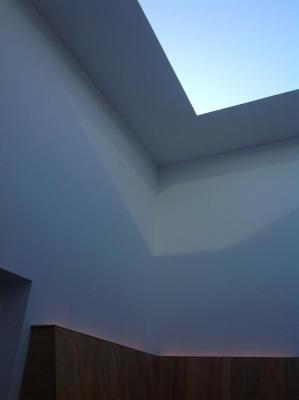
I think of a frame also because it’s on the top floor of PS1, so by the time I step insideMeeting, I have adjusted my gaze to see objects that have been selected and presented to me with clear beginnings and ends. I am focusing on what’s within the walls, rather than out the windows. When Turrell frames the sky I feel suddenly tricked into thinking that the sky also has a beginning and an end, and that there is a specific part where I should look, even if it is just empty and grey. Sometimes a bird will fly from one side to another, seeming to perfectly bisect the rectangle like scissors cutting a page in half. A cloud might sit directly in the middle, and then I think I know where I am meant to look.
I admit that I mostly go to PS1 just so I can sit inside Meeting. I enter the building and try to look like I’m moving slowly through the galleries, contemplating the sculptures and video installations like everyone else, when really I just want to run up the stairs into that cold, bright room. Meeting is a permanent installation, and I sometimes don’t want to take the time to be moved by something new. I want to go straight to where feeling something is guaranteed.
In an interview with Art 21 in 2001, Turrell talks about entering a Quaker meetinghouse with his grandmother when he was a child. He remembers asking her what they would do inside and she said, “We’re going inside to greet the light.” I hadn’t thought of Meeting as a spiritual space until I heard this. I wasn’t raised with a religion, and I’m always hesitant to recognize anything as a spiritual experience. As someone who has never belonged to a temple or a church, I’m not quite sure how to recognize a spiritual place that is perhaps my own. PS1 is close to where I live, and I get a student discount so it’s easy to go sometimes when I’m feeling stressed out or sad. Something always makes me feel better, even if it’s just because the art is sadder than my sadness, or weirder. I know that I am drawn to this place in a way I’m drawn to things that overwhelm me; things which I do not understand.
I have been doubting myself lately about whether I should enter works of art in the way that I do, which is with a lot of emotion, and always looking for a way to personally relate. I remember when I was a freshman in college, in my first literature class, I told my TA that I had trouble writing essays about books I didn’t love. The advice she gave me was to write with “passionate dispassion.” I teach now, and this is one of the most common dilemmas I hear from students: How do you write about something you don’t care about? I usually tell them to find an angle that interests them, or think about why anyone else would care. (But do they even care who cares?) I tell them they can still find something valuable in a book or a work of art, even if they aren’t emotionally moved by it. I’m not yet satisfied with my answer.
On a first date recently I told someone that I write about conceptual and performance art, and his reaction was: “You seem like a smart person. Why would you be interested in that kind of art?” I replied that a lot of people who are much smarter than both of us are also interested. It was hard for me to explain my reasons for being drawn to this kind of art without getting very, very personal. And I wasn’t surprised by his reaction. It’s not an unusual response to putting a common object in a museum and calling it art; putting a frame around a piece of the natural world. Anyone can put a dead fish in a gallery. Why does that make Damien Hirst an artist? Turrell’s piece speaks directly to reactions like this. We don’t necessarily have to be seeing something new in order to change the way we see. When someone says, “I could do that,” the answer I’m satisfied with is, “You didn’t.” Maybe Turrell’s piece isn’t art, in the way that a park isn’t art, or in the way that we ever designate wilderness, putting a frame around it to make a natural reserve. A museum asks me to look at the sky. So does an observatory. So does Central Park. Sometimes I need to be reminded.
A print of one of Turrell’s plans for a light installation is up at Woodward Gallery in Chinatown. I didn’t do my research before going to see it, so I was disappointed that when I got there, only one print was up, and it just looked like an architect’s blueprint. I scoured it for some sign of poetry, read every note and sketch hoping to find the same voice I’d heard in interviews, when he’d said something like, “…to find the light within, literally.” The blueprint refuses to reproduce any of the sensations caused by the finished product. Somehow I had expected a description, or some indication of why the finished product would be beautiful and moving, but it’s only a plan for a room, as it should be. It started to rain when I left, and I had a long walk and three trains home ahead of me. I thought, I could have just stayed home and looked at the image of this print online. I could have lied and said I saw it in person, and no one would know the difference.
I should listen to the advice I give my students and work at finding value in a piece of art that doesn’t move me. I started to think about how my entire journey to the gallery was part of experiencing Turrell’s blueprint. The beginning and end became clearer; it could have started when I got on the B train, which I never take. (What is art if not a new experience?) When I got to the gallery the owner’s two dogs barked at me, and he apologized profusely. I looked at other prints by other artists and when I left I forgot for a moment how to get back to the train. The people I asked for directions, the book I read on the train, the ads I looked at, were all inside of an experiential frame, for me. I looked up and Turrell put a frame around the rain that fell on my face.
The last time I was at PS1 I heard Jeff Buckley’s “Hallelujah” coming from the VW Dome, an exhibition space in the courtyard. My mom used to love this song, and I thought of the last months of her life, when I would sing it with her in the hospital. I was trying to leave when I heard it, and I thought maybe I should keep walking.
I have been annoyed in the face of my grief lately, which feels old and stale. I keep thinking it should be fading rather than sneaking up on me with the same strength it had when I first met it. In addition to being annoyed, I am also becoming self conscious about the fact that I search for art I can interpret to be about mourning. I seek out pieces that remind me of my mom. It’s been five years since she died, and no matter how many times I’m told that grief has no time limit, I still feel frustrated. When my date said, “Why would you like that kind of art?” I was afraid he knew exactly why. Perhaps he saw that I’m not “interested” in this kind of art but that I’ve been driven to it because of something tragic; because something is wrong with me.
I like conceptual and experiential art because these pieces often feel like rituals in the face of complicated realities. I don’t want to hear about the abounding variety of mourning customs from around the world. I want to learn about my own. My own grief casts a shadow over every object, despite its commonality. I like seeing objects reframed in places I wouldn’t expect to find them: a urinal in a museum versus a urinal in a bathroom; a dead shark in an art gallery versus a dead shark in a natural history museum, or a live one in an aquarium, or in the wild. Recontextualizing these objects feels like what happened to my world, which felt like it was reframed in its entirety by my mother’s death. Her absence touched every corner.
About once a year for the past five years, a therapist or a friend will ask me if I know where my mom is. They ask where I think she went, and I have no idea. I never feel satisfied with the answers I test out. The closest I get is when my sister tells her son that his grandmother lives in the sky. The Pacific Ocean also seems like a decent answer, because her ashes are there. I try to think of where she may have wanted to go. I have sat in Meeting and remembered how I looked at the sky after I left the fourth floor ICU where I last saw her body. When I got outside I looked up almost automatically, because I wanted to be somewhere else, and when we want to be somewhere else we look at the sky, don’t we? But she didn’t want to be somewhere else, she was trying to stay here.
Inside the VW Dome was a piece by Turkish artist Ferhat Özgür called I Can Sing. It’sa film in which an Anatolian woman in a headscarf stands in front of a backdrop of contemporary Ankara. She is lip syncing Jeff Buckley’s song but the timing is off and her mouth moves just behind his words. Sometimes it feels like a joke. She looks melodramatic, but sometimes the sadness in her face is strikingly genuine and Jeff Buckley is the joke, singing lines such as “Remember when I moved in you, the holy dove was moving too” too fast for her to keep up. I’d never noticed how sexual this song was, and I felt suddenly uncomfortable seeing these words mouthed by this middle-aged woman, who looks like someone’s mother. I sat in the dark dome and watched until the song ended, and I went back out into the world.
Dale Megan Healey’s work has appeared or is forthcoming in Pequin, Prick of the Spindle, DIAGRAM and elsewhere.



